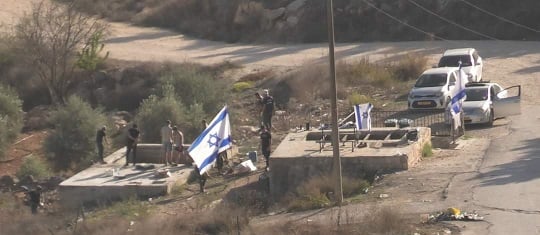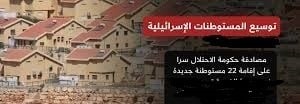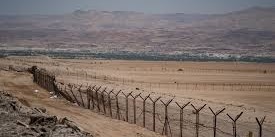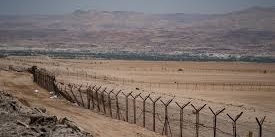By: Madeeha Al-A’raj
The National Bureau for Defending the Land and Resisting Settlements stated in its latest weekly report , that according to International and Israeli organizations, studies showed that the Occupying State (OS) controls about 88% of the Palestinian water resources in the West Bank, and allows illegal settlers to free access and use them without any hindrance, whether for drinking and domestic purposes or for agricultural and industrial projects in the settlements, knowing that the settlers in the West Bank consume nine and a half times of water more than the Palestinians.
Noting that the water available to the Palestinians in the West Bank is, 105,000,000 cu.m3, which is less than what was available in 1995 in accordance to the Oslo Accords, which was 118,000,000 cu.m3, while the amount of needed water according to international standards is 400,000,000 cu.m3, which means the Palestinians are merely getting a quarter of their water needs.
This is not the main subject, but merely a reminder of the facts that confirm the Jewish settlement in the West Bank, including Jerusalem, has gone a long way in creating a system of racial, segregation and discrimination, where water is an example to that. In any case, right to get water is a thing, and the use and seizure of water to deepen the occupation and settlement is another thing. Hence, the attempt to shed light on the plan to control water springs in the West Bank is a tool for settlers to control ever larger areas of Palestinian land, and transform them into settlement activities.
The case is that the OC controls and seizes Palestinian ground and surface water and sells what it deems necessary to the Palestinian side through the Israeli water ‘Mekorot’ Co., and leaves the settlers free to act in stealing spring water, specifically in the Areas C, in accordance to the agreements between the two parties (Palestinian and Israeli). The total number of seasonal and perennial springs in the West Bank is estimated, according to the Palestinian Hydrologists Association, at 714 springs, of which about 350 are permanent, ranging from weak to medium to abundant. 56 of these springs are located near Israeli settlements, with about half of these springs located in the Ramallah Governorate, 29, and in the Nablus Governorate, 10, while the rest are distributed among the rest of the West Bank governorates, especially Salfeet and Bethlehem. 30 of these springs were originally under complete control of the settlers, with no possibility of access to them by Palestinians before the war.
As for the rest, a number of them have been transformed, especially in the circumstances of the brutal war waged by Israel on the Gaza Strip and the West Bank, into military zones that Palestinians are prevented from reaching or approaching by military orders from the occupation army and through acts of intimidation, threats and violence, also committed by the settlers.
The OC claims that it deals with the springs as environmental sites that must be preserved and protected, but in reality they are working to deprive the Palestinians from benefiting from them as environmental sites or as a source of water needed for drinking and agriculture. At the same time, they are encouraging the establishment of nearby and adjacent settlement blocs that turn them into sites for rebuilding the settlers’ relationship with nature through paths and sites for hiking, recreation, and “Jewish purification,” in addition to using them as tourist attractions as a step on the path to settling them by transferring the Jewish population from the Israeli interior to the West Bank. This is practically the same policy that the OS has adopted in the Galilee, coastal, and Negev areas.
This is also confirmed by the United Nations Office for the Coordination of Humanitarian Affairs’ report – (OCHA), which indicated that these springs are located near settlements and that 30 springs have been completely seized and Palestinians are prevented from entering them, while the remaining 26 springs remain at risk of being seized by settlers as a result of their regular tours and patrols.
According to the report, after the Palestinian presence has been reduced or eliminated, settlers begin to develop the springs into tourist attractions to support the settlements’ tourist infrastructure with the aim of consolidating them. Settlers begin to transform the spring areas into tourist areas by building pools and picnic areas, changing the names, and placing signs for the names of the springs in Hebrew.
These springs remain the largest source of water for irrigation and an important source for domestic consumption for Palestinians. The report indicates that seizing the springs is an extension of settlement expansion in the West Bank, noting that it is illegal under international law.
As for the Kerem Navot organization, it studies the Israeli land policy in the West Bank, it also confirms that “there are more than 60 springs in the central West Bank that settlers covet by renovating and renovating about half of them, dispossessing their owners and preventing Palestinians from approaching them. However, seizing the springs is part of a much more ambitious plan, which seeks to control the remaining open spaces in the West Bank, with the aim of isolating Palestinian villages, rather than isolating settlements, and seizing more land. This is being done, according to the organization, by creating bathing areas and hiking trails, establishing graves for Jewish spiritual figures as “holy sites,” and developing picnic sites, all located on private land owned by Palestinians.”
Settlers not only cut off and destroy the water supply lines that supply the villages with water from the Israeli Mekorot Co. from time to time, but they also prevent them from filling water from the springs of their villages, as is the case with the settlers in the settlements of ‘Eli, Shilo and Shevut Rachel’ with the water springs surrounding the village of Qaryut in the Nablus Governorate. After the settlers took control of ‘Ain Qaryut’ and ‘Al-Khawaniq’ and blocked the roads with earthen barriers to the other springs, the people of the village, known for its many springs, had no choice but to buy water at an high price to meet their need for drinking water and irrigate their crops.
Recently, in wartime conditions, the settlers seized one of the 3 most important water springs out of 5 owned by Qaryut, and prevented its residents, numbering 3,000 people, from approaching them, after annexing the area of influence to the settlements, which control 17,000 out of 21,000 dunams of the village’s lands. Since the war began on Oct. 7, settlers have not left the Ein Silon area, where they have made extensive changes to the area, by placing umbrellas, benches and children’s games, and giving it a tourist character.
They have taken turns guarding the place, to prevent Palestinians from approaching under threat of arms, after they destroyed a children’s park that the village had established in the area and destroyed the surface of the water reservoir of that spring, which covered the village’s need for drinking water, household uses and agriculture in previous years, and they turned that reservoir into a swimming pool for the settlers.
Settlers’ attacks and their ambitions to control water springs are not individual acts or spontaneous practices, but rather an organized act that complements the occupation authorities’ theft of Palestinian water in general, both groundwater and surface water. The 3 Solomon’s Pools in the town of Artas, south of Bethlehem in the West Bank, which cover an area of more than 30 dunams and are surrounded by a similar area of nature reserves, are a clear example of this, as settlers repeatedly storm the pools under army protection to perform Talmudic rituals. The Palestinians are seriously concerned about the control of the pools and their inability to restore and develop them, due to the dangerous expansion of the nearby’“Efrat settlement’.
Some residents of theHusan town in Bethlehem governorate also fear that their water springs will be taken over by settlers, especially in the “Ein al-Hawiya” area, which supplies dozens of farmers with water to irrigate their crops, after the settlers managed to take control of about 4,000 dunams of the town’s land to build the “Beitar Illit” settlement in the “Gush Etzion” settlement bloc. They also prevent Palestinians from restoring or rehabilitating the spring under the pretext that it is located within Area C. The chances of the residents of the village of Nabi Saleh, west of Ramallah, are almost non-existent. They were the ones who used to benefit from “Ein al-Qaws” which is located near their village, due to the settlers’ control over it and the renaming of the place with a Jewish name, “Ma’an Meir”.
It has become completely forbidden for Palestinians to benefit from or approach it. In Dura al-Qar’, the cold-blooded murder of citizen Moh’d Fawaqa, 21 while he was near the village’s water spring on Oct. 18 confirms how risky it is for a Palestinian citizen to try to reach the water springs, especially after the state armed the settlers and absorbed them into organized militias in the “emergency teams” and others.
On the lands of Palestinian citizens in the villages of Salem, Beit Jann, Deir al-Hatab and Azmut to the east of the city of Nablus, there are water springs that benefit the residents of these villages, the most important of which is the “Ain al-Kabira” spring, which by a decision of the occupation authorities, the name of that spring was changed to “Ain Kfir,” the name of one of the military nurses, who were killed in the battle of “Qalaat Shaqif” in southern Lebanon in 1982. The nearby settlement of “Alon Moreh” claims that it falls within its area of influence on the lands of a state that the commander of the occupation forces in the West Bank classified based on a military order issued as a model for this conflict over water and its sources in the West Bank, which resulted in great suffering by depriving citizens of springs that they have frequented for generations. The occupation army generally says that it allows Palestinians to access the springs, but when a security need arises related to preventing friction in a specific location, the army forces act according to security considerations.
The condition of the water springs in the Palestinian Jordan Valley is no better than the examples we mentioned above. The springs in this area are also threatened of seizure. A group of settlers seized the ‘Khallet Khader spring’ in Khirbet al-Farisiya in the northern Palestinian Jordan Valley, and built a water collection pool near it, in a move that gives clear indications of the intention to further control the spring water and collect rainwater in the area and deprive Palestinians of the right to access it.
Earlier this year, the settlers also seized the Ein al-Hilweh spring in the northern Jordan Valley and carried out construction and restoration work in its vicinity. Later, they established a park in the area and deprived Palestinians from using the spring, which is the main source of water for dozens of families. On the ground, the occupation authorities are waging a brutal war on the West Bank in parallel with their brutal war on the Gaza Strip.
They promise the settlers with more weapons, including those who are not participating in the ‘emergency teams’ or ‘ready teams’ which portend dire consequences and a widespread deterioration in the security situation. These promises are accompanied by threats issued by Israeli ministers to turn the West Bank into a new Gaza Strip, as the Israeli Minister of Finance and Minister of Settlement in the Ministry of Army, Bezalel Smotrich, announced during his visit to the “Bat Hefer” settlement on the path of the Aparthied Wall near the city of Tulkarm, that Israel must start a ‘defensive’ war in the West Bank to block the chances of establishing a Palestinian State, because ‘anyone who talks about establishing a Palestinian state is wasting the blood of settlers and endangering the existence of the state.’ He threatened to turn Tulkarm Governorate into rubble like Gaza.
In such an atmosphere, which prevails in the occupation government and enjoys wide support from its PM Netanyahu, the settlers find their opportunity, not only to steal the spring water in the West Bank and to pursue the Bedouin and Pastoral Communities, but also to expand wherever they can and to establish more settlement outposts and terrorist pastoral farms, especially in the governorates of Bethlehem and Nablus. Last week, settlers set up two tents on the lands of the “Jabal Abu Zeid” and “Khallet al-Qatn” areas, part of which belongs to the lands of “Deir Artas”, south of Bethlehem, with the aim of seizing additional areas of land for the benefit of expanding the borders of the “Efrat” settlement.
Within the context, the occupation forces and settler gangs closed agricultural roads in the town of Al-Khader with cement blocks to prevent farmers from reaching their lands. In the Kisan desert, settlers stormed the ‘Um Zaytouna area’ and stole agricultural supplies and electrical tools. Others set fire to lands in the “Wadi Qadis” area in the village of Husan, planted with grapevines and olive trees, which led to the destruction of a number of them. Meanwhile, settlers from the “Beitar Illit” settlement began paving a settlement road in the village’s lands across agricultural lands in the “Wadi Qadis” area, reaching the “Ein al-Taqah” area, with a length of about 3 km, with the aim of connecting the settlement outposts to each other.
To the south of Nablus, a bulldozer belonging to the ‘Magdolim settlement’ closed two agricultural roads in the northern area of the town of Qasra, in order to complete the work of leveling lands in the area, and uprooting the remaining olive trees for the purpose of settlement expansion. A group of settlers also attacked a number of homes in the southeastern area of the town under the protection of the occupation army, which led to confrontations with the occupation forces and settlers, who fired live bullets at citizens, resulting in the injury of a young man with live bullets in his abdomen.
In the neighboring village of Jalod, settlers bulldozed areas of land south of the village in preparation for seizing them, noting that the bulldozing is only meters away from citizens’ homes. Others began construction and expansion work in the ‘Shavei Shomron settlement’ on the lands of Sebastia, Naqoura and Deir Sharaf, pouring concrete on citizens’ private lands, and trying to impose a de facto in order to seize more lands, and targeting historical and archaeological sites in that area.
List of Israeli Assaults over the Last Week Documented by the National Bureau:
Jerusalem:
- Demolishing a three-story residential building in the Silwan town, south of Al-Aqsa Mosque, and prevented citizens from accessing its vicinity, as well as a printing press in the town of Issawiya belonging to Moh’d Alian. Moreover, they for the second time in a month, demolished commercial establishments belonging to the sons of the late Bassam Fazaa Al-Omari in the Hizma town, northeast of the city of Jerusalem. These were 2 shops, and before them shops, a car wash, and a sheep tent belonging to Jerusalemite, Jaber Muharab Najib.
- Bulldozing agricultural land and retaining walls in the Tablas area in the town of Hizma.
- Storming the Adila courtyard in the Ras-Amud neighborhood and manually demolished home of Mah’d Adila, and delivered demolition orders to a number of commercial stores located near the Jaba Bridge in the al-Ram area in the occupied Jerusalem, including the Jaba Bridge, which is located above the targeted street and connects the towns of Jaba and al-Ram, with the aim of expanding the street located between the two checkpoints to facilitate the passage of settlers from occupied Jerusalem to the settlements of the West Bank after the occupation finished building a tunnel for vehicles under the Qalandia military checkpoint to become a main settlement road linking Jerusalem to the West Bank used only by settlers.
Hebron:
- Attacking the Bani Naim Municipality’s employees while they were working on extending water lines in the Qasr area in the Bani Naim town, which resulted in the injury of the deputy mayor, Nader Hamidat.
- Attacking homes in Wadi al-Husayn with stones and hurled threats, used bad words and obscene language, which caused a state of panic among children and women.
- Stabbing citizen Jamal Obeid Ahmed Awad, 46, and his son Moh’d, 23 from the town of Yatta, with sharp tools, stabbed them several times while they were crossing the ‘bypass road’ near the Beit Einun junction east of Hebron, which caused them to sustain moderate injuries, after which they were transferred to the Ahli Hospital in the city of Hebron.
Bethlehem:
- Attacking farmers while they were harvesting wheat, and seized their crops in the lands of “Wadi Al-Abyad”, “Abu Zaarour” and “Fateh Sadra” in the village of Al-Minya, southeast of Bethlehem.
- Setting fire to lands in the ‘Wadi Qadis area’ in the village of Husan, west of Bethlehem, planted with grape and olive trees belonging to citizens from the Hamamra and Shusha families, which led to the destruction of a number of them.
- Uprooting 300 grape seedlings, 100 olive seedlings, and 100 almond seedlings, and destroyed a ‘grape arbor’ and vegetable crops – zucchini and cucumber – in the lands of ‘Al-Ahmadiya’ in the Faghur area, belonging to citizens from the Al-Khader town.
Ramallah:
- Attacking the outskirts of the town of Deir Dibwan, east of Ramallah, from the eastern side, and burned tents and a sheep barn, belonging to citizens Moh’d Nazzal Musbah and Islam Nazih Awadah.
- Storming the Um Safa village and set up a number of tents in the ‘Ras al-Jabal area’, which belongs to the residents of the villages of Um Safa, Deir al-Sudan, and Ajul, in preparation for seizing it, which led to confrontations, during which the occupation forces fired tear gas bombs at the citizens.
- Storming the Jaljulia village, and positioned at the ‘Sala’a spring’.
Nablus:
- Storming the archaeological site in the town of Sebastia under the protection of the occupation forces and assaulted the owners of shops in the area and forced them to close their doors.
- Torching lands located near the main entrance to the village of Duma, south of Nablus, which led to the spread of fires among olive groves and crops.
- Attacking homes of citizens in the ‘Ras al-Muhalal area’ east of the Burqa village, and burned agricultural lands and crops, and a sheep barn.
Salfeet:
- Torching large areas of olive groves belonging to citizens Saleh Al-Nimr and Rashid Al-Nimr from the Kafr Al-Dik town, while settlers attacked the vehicles of citizens who rushed to put out the fires and assaulted a number of them, including citizen Mufid Fawzi, who was transferred to the hospital.
Jordan Valley:
- Demolishing 4 houses in the city of Jericho, in the Al-Murshat area adjacent to Aqabat Jaber Refugee Camp, they demolished a house belonging to Tariq Jamil Najm; under the pretext of not having a license, they also stormed the village of Ad-Duyuk Al-Tahta, and demolished 2 houses, and the foundations of a third house under construction, belonging to Moh’d Ahmad Samarat from Ad-Duyuk, while settlers destroyed agricultural crops.
- Tearing up more than 80 ‘sacks of hay and bales of straw’, and in the “Arab Al-Malihat” Bedouin Community, settlers seized dozens of sheep belonging to Abdul Latif Atallah Suleiman.
- Stealing a water tank used for watering livestock and placed it near the ‘Rotem settlement’ near the area in Khirbet Al-Farisiya.
 المكتب الوطني للدفاع عن الارض ومقاومة الاستيطان منظمة التحرير الفلسطينية
المكتب الوطني للدفاع عن الارض ومقاومة الاستيطان منظمة التحرير الفلسطينية




